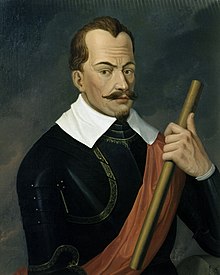
Back Albrecht von Wallenstein Afrikaans ألبرشت فون فالنشتاين Arabic البرشت فون فالنشتاين ARZ Альбрэхт фон Валенштайн Byelorussian Албрехт фон Валенщайн Bulgarian Albrecht von Wallenstein Breton Albrecht von Wallenstein Catalan Albrecht z Valdštejna Czech Albrecht von Wallenstein Danish Wallenstein German
You can help expand this article with text translated from the corresponding article in German. (August 2023) Click [show] for important translation instructions.
|
Albrecht von Wallenstein | |
|---|---|
 Portrait by Julius Schnorr von Carolsfeld, after a 1629 original by Anthony van Dyck | |
| Birth name | Albrecht Wenzel Eusebius von Wallenstein |
| Born | 24 September 1583 (Old style: 14 September) Heřmanice, Bohemia |
| Died | 25 February 1634 (aged 50) Cheb, Bohemia |
| Buried | Mnichovo Hradiště, Bohemia |
| Allegiance | Catholic League |
| Branch | Imperial Army of the Holy Roman Emperor |
| Years of service | 1604–1634 |
| Rank | Generalissimo |
| Battles / wars | Long Turkish War Uskok War
|
| Awards | Order of the Golden Fleece |
Albrecht Wenzel Eusebius von Wallenstein, Duke of Friedland (ⓘ; 24 September 1583 – 25 February 1634), also von Waldstein (Czech: Albrecht Václav Eusebius z Valdštejna), was a Bohemian[a] military leader and statesman who fought on the Catholic side during the Thirty Years' War (1618–1648). His successful martial career made him one of the richest and most influential men in the Holy Roman Empire by the time of his death. Wallenstein became the supreme commander of the armies of Holy Roman Emperor Ferdinand II and was a major figure of the Thirty Years' War.
Wallenstein was born in the Kingdom of Bohemia into a poor Protestant noble family. He acquired a multilingual university education across Europe and converted to Catholicism in 1606. A marriage in 1609 to the wealthy widow of a Bohemian landowner gave him access to considerable estates and wealth after her death at an early age in 1614. Three years later, Wallenstein embarked on a career as a mercenary by raising forces for the Holy Roman Emperor in the Uskok War against the Republic of Venice.
Wallenstein fought for the Catholics in the Protestant Bohemian Revolt of 1618 and was awarded estates confiscated from the rebels after their defeat at White Mountain in 1620. A series of military victories against the Protestants raised Wallenstein's reputation in the imperial court and in 1625 he raised a large army of 50,000 men to further the Imperial cause. A year later, he administered a crushing defeat to the Protestants at Dessau Bridge. For his successes, Wallenstein became an imperial count palatine and made himself ruler of the lands of the Duchy of Friedland in northern Bohemia.[2]
An imperial generalissimo[3] by land, and Admiral of the Baltic Sea from 21 April 1628,[4] Wallenstein found himself released from service in 1630 after Ferdinand grew wary of his ambition.[5] Several Protestant victories over Catholic armies induced Ferdinand to recall Wallenstein (Gollersdorf April 1632), who then defeated the Swedish king Gustavus Adolphus at Alte Veste. The Swedish king was later killed at the Battle of Lützen. Wallenstein realised the war could last decades and, during the summer of 1633, arranged a series of armistices to negotiate peace. These proved to be his undoing as plotters accused him of treachery and Emperor Ferdinand II ordered his assassination. Dissatisfied with the Emperor's treatment of him, Wallenstein considered allying with the Protestants. However, he was assassinated at Eger in Bohemia by one of the army's officials, with the emperor's approval.
- ^ Rabb, T. (1964). The Thirty Years' War: Problems of Motive, Extent, and Effect. Boston: Univ. of Am. Press. p. 123.
- ^ Mortimer, G. (2010). Wallenstein: The Enigma of the Thirty Years War. p. 69. doi:10.1057/9780230282100. ISBN 978-0-230-27212-5. Archived from the original on 27 September 2021. Retrieved 25 July 2018.
- ^ "Wallenstein, Albrecht Wenzel Eusebius von, Herzog (duke) von Friedland, Herzog von Mecklenburg, Fürst (prince) Von Sagen", Encyclopædia Britannica Ultimate Reference Suite, Chicago: Encyclopædia Britannica, Inc., 2010
- ^ Coxe, W. (1852). History of the House of Austria vol. II (3rd ed.). London: H.G. Bohn. p. 203. Archived from the original on 27 September 2021. Retrieved 2 July 2018.
- ^ Steinberg 1998.
Cite error: There are <ref group=lower-alpha> tags or {{efn}} templates on this page, but the references will not show without a {{reflist|group=lower-alpha}} template or {{notelist}} template (see the help page).